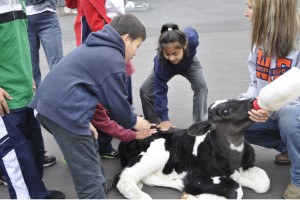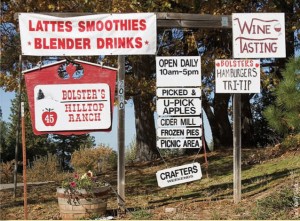Read the original story on SF Gate
A patchwork of food, farming, conservation and environmental groups fear that lawmakers could act on the 2012 Farm Bill as early as this week with no input from California – the largest agricultural state in the nation.
Leaders of the House and Senate Agriculture committees are proposing $23 billion in cuts – the 2008 Farm Bill’s five-year budget exceeded $300 billion – and could take their proposed legislation directly to the new congressional “supercommittee” to be passed without votes in their own committees or in Congress.
The supercommittee, made up of six senators and six representatives from both parties, has been tasked to come up with $1.2 trillion in federal budget cuts by mid November to reduce the deficit.
A new Farm Bill, which sets the budget for everything from farm support programs and renewable-energy research to food stamps and conservation initiatives, is passed every five years. Many in California’s agriculture community are concerned the new bill will show favoritism to commodity crops – corn, soybeans, wheat, cotton, rice and peanuts – leaving California, largely a specialty crop state emphasizing fruits, vegetables and nuts, with fewer funds for organic farming, environmental protection and research programs.
Currently, California receives only about 5 percent of the money set aside for farm programs despite producing 12 percent of the country’s total agricultural revenue. And with the proposed cuts, the state could get even less.
“To think that a Farm Bill is being written in a few weeks behind closed doors is crazy,” said Kari Hamerschlag, a senior analyst for the Environmental Working Group, a Washington and Oakland nonprofit that is outspoken about toxic chemicals, farm subsidies and land use. “We think that it’s important that California stand up and look out for what is best for the state.”
Groups such as the California Association of Food Banks, California State Grange, Center for Food Safety, Community Alliance with Family Farms and the Ecological Farming Association have sent a petition with more than 16,000 signatures to California’s congressional delegation and to Gov. Jerry Brown, urging them to make sure that the state gets funding to protect conservation, nutrition and research programs.
What the state wants
In the meantime, the California Department of Food and Agriculture submitted to the Ag committees and supercommittee its recommendations for the Farm Bill, asking to either maintain or in some instances increase funding for conservation, job creation, revitalizing rural economies, investing in research and educationand improving health and nutrition.
Karen Ross, California’s secretary of food and agriculture, said the recommendations are based on the state’s diverse needs. California produces more than 400 different crops, employs 800,000 people and generates annual revenues of $37.5 billion, according to the CDFA.
But she knows that to meet the nation’s mandate to reduce spending some programs will have to go.
“We’re concerned about nutrition programs,” she said. “More people than ever are receiving assistance now from food programs.”
California’s recommendations call for maintaining nutrition funding at current levels and removing eligibility barriers for programs such as SNAP (food stamps) and free school lunches. Last year the state received $6.3 billion in federal nutrition funding.
“There isn’t going to be any program that goes unscathed by the cuts,” said Rayne Pegg, assistant manager of national affairs for the California Farm Bureau Federation. “But getting healthy food access is critical.”
Pest prevention
In addition, the state’s proposal includes recommendations to increase funding for pest prevention nationwide from $50 million to $100 million. Ross said the key to successful farming is to be proactive in eradicating invasive insects that kill crops. Other suggestions include $350 million over five years for specialty crop block grants; maintaining conservation and organic farming programs at the same level and reducing the cost of crop insurance for organic farmers.
Ross said for the first time California is also asking that money be set aside for programs and grants that will invest in young and new farmers. “It’s an area we have to think about if we want to have food security in the future,” she said.
Hamerschlag said she applauds the proposal and specifically supports substantial funding toward nutrition, conservation, organics, local and regional food systems and rural development.
“What we’d like to see is a real shift in the subsidy money used for commodity crops go to healthy food and conservation research.”
From 2008 to 2010, commodity crops across the nation received $20 billion in subsidies, whereas fruits, nuts and vegetable farmers got $3 billion in federal funds and grants, according to the Environmental Working Group, which collects its data from the USDA. Although California receives few subsidies, the state’s upland cotton growers received a combination of direct payments and subsidies totaling $198.1 million in 2009. They only generated $85.8 million in sales that year, Hamerschlag said.
Specialty crops in California received $200 million in federal funds and grants for procurement, marketing, promotion and research programs in 2009. Those crops were valued at $19.5 billion, she said.
End direct payments
“Looking at these numbers, California would be well placed in shifting (those cotton subsidies) into conservation, fruits and vegetables,” Hamerschlag said. There is talk of the new bill eliminating the direct-payment program, which are subsidies based on past acreage planted regardless of commodity prices. The new proposal calls for a program that would only apply to planted acres when prices drop to certain levels.
While some cheer the end of the direct-payment program, there are many in California who still fear that Sen. Pat Roberts, R-Kan., Rep. Frank Lucas, R-Okla., and Rep. Collin Peterson, D-Minn., the Ag committees’ top leadership, will look out for their big commodity states. Many Californians are placing their faith in the fourth member of the leadership, Sen. Debbie Stabenow, D-Mich. Like California, her state grows mostly specialty crops.
“We’re not a traditional farm bill recipient,” said Pegg of the California Farm Bureau Federation. “So it’s important for us to prioritize. It’s not over until it’s over.”
E-mail Stacy Finz at sfinz@sfchronicle.com.









